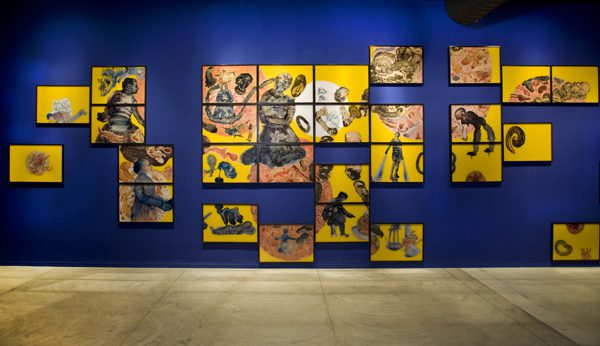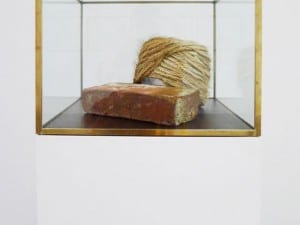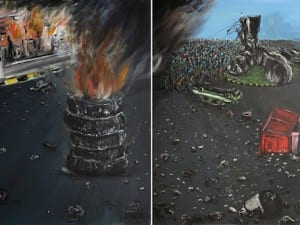Spanning nine months and encompassing five decades of the artist’s oeuvre from 1969 to 2014, You Can’t Keep Acid in a Paper Bag is an iconic exhibition for several reasons. Not only is it the first comprehensive retrospective of Nalini Malani’s work to be exhibited in India – bringing home several installations and projects that have never been shown in her home country – it is also one of the largest solo exhibitions to be held at the Kiran Nadar Museum of Art (KNMA).
Perhaps a display spread over just three rooms will not seem much like a retrospective; the Museum and curator Roobina Karode have divided Malani’s work into three “chapters”, each on display for approximately three months. The first chapter (30 January – 10 May) traced the artist’s early years and experiments with visual media and the moving image, as well as her interest in mythology and connecting the past with the contemporary. Works included were the film installation Utopia (1969-1976), the video-play Mother India (2005), and the reverse painting Cassandra (2009).
The second chapter of the retrospective, which was on view until 25 August, is a tryst with “unconventional women” from Greek mythology – especially the deviant Medea, who appears in Malani’s work time and again. Through collaborative theatre/performance pieces, shown here as video installations, Malani linked the Medea myth with the upheavals and riots in India in 1992-93, using them as the backdrop of her stage. Entitled Medeamaterial a Landscape with Argonauts (1993), created in collaboration with Alaknanda Samarth and adapted from Heiner Müller’s Despoiled Shore, the performance interpreted the myth through the lens of colonialism, depicting Jason and the Argonauts as colonisers of Medea’s native land.
The second room further expands on the myth: showcasing an ephemeral charcoal wall drawing, Medea as Mutant (1993/2014), 12 panel digital prints on archival Hahnemühle paper depicting the myth in its entirety, and three “robes” that are reverse paintings of watercolour and enamel on Mylar and mark pivotal turning points in Euripedes’ script of Medea – entitled The Bridal Gown (1993), The Robe of Vengeance (1993) and The Alchemist’s Robe (1993). An audio soundtrack defines the mood, and text on the wall acts as a signifier of Malani’s position: “If more attention were paid to the female thought process, perhaps we might reach something called progress.”
Fittingly, this line leads the viewer into the next room, devoted to 42 prints inspired by Christa Wolf’s writing on the Greek myth of Cassandra, in collaboration with Robert Storr. Malani’s retelling of this story, entitled Listening to the Shades (2008), is an exemplar of her feminist stance and depicts “what has been denied to women”, with Cassandra symbolising “the unfinished business of the women’s revolution”. Using the myth to represent the metaphorical blindness and unheeded warnings that have led to war, death and destruction throughout history, Malani’s paintings depict parts of the brain and nervous system, troubling visions, female figures and war imagery in an emotional and urgent tableau.
The final chapter of the retrospective opens to the public on 17 September and runs until 30 November. It will explore Malani’s experiments with the gallery space through in situ or ephemeral art, such as the wall drawings in City of Desires (1991) that transformed the gallery into a public arena, and the unique installation style that she created and termed “video/shadow-play”. The issues of colonialism, Orientalism as well as mythology remain in focus.
Ongoing for nearly a year, but also transforming every few months, You Can’t Keep Acid in a Paper Bag is a new kind of curatorial experiment. Additionally, it provides an immersive experience into the work of an artist who bridges the historical with the contemporary so effectively that her work never ceases to be relevant.
You Can’t Keep Acid in a Paper Bag, until 30 November, Kiran Nadar Museum of Art (KNMA), 145, DLF South Court Mall, Saket, New Delhi, India.
Kriti Bajaj
Credits
1. Cassandra, 2009, 30 panel reverse painting on acrylic, courtesy of Kiran Nadar Museum of Art.





